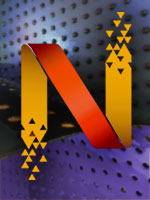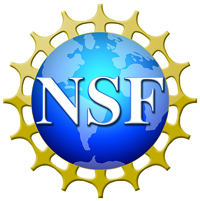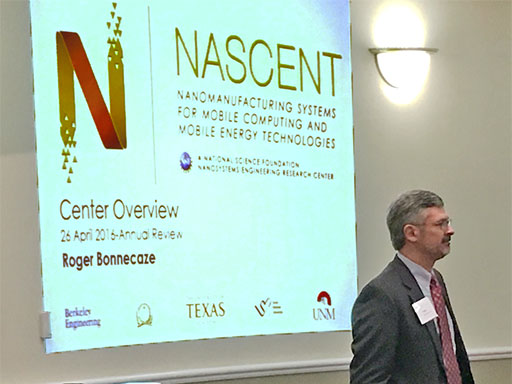Recent News
CHTM Joins NSF's NQVL Pilot Projects
August 9, 2024
OSE PHD, Dr. Xuefeng Li - Wins The Outstanding Interdisciplinary Graduate Programs Award
May 10, 2024
Dr. Ali Rastegari - 2024 OSE Best Dissertation Award Winner
May 10, 2024
2024 OSE Spring and Summer Graduates
May 10, 2024
News Archives
NASCENT ERC site visit hosted by CHTM
May 3, 2016 - Sharon Steely

A National Science Foundation Engineering Research Center (ERC) is a large-scale, multi-university program funded for at least $4M per annum for 10 years. The ERC Program was created by the National Science Foundation (NSF) in 1985 to develop a long-term government-industry-university partnership to strengthen the competitive position of U.S. industry and technology in a global economy.

Currently, there are 20 active ERCs in the United States funded by the National Science Foundation. Of these, New Mexico's flagship research university, UNM, has the distinction of partnering in 4 ERCs. Only UC Berkeley exceeds UNM with a total of 6 ERC partnerships. CalTech and MIT each partner in 3 ERCs. At UNM, the Center for MicroEngineered Materials (CMEM) is a partner in CBiRC, the ERC for Biorenewable Chemicals. The Center for High Technology Materials (CHTM) partners with the Lighting Enabled Systems and Applications (LESA - smart lighting), QESST (solar energy), and NASCENT (Nanomanufacturing Systems for mobile Computing and Energy Technologies) ERCs. The University of Texas at Austin is the lead partner in the NASCENT ERC with UNM and The University of California at Berkeley, along with the Indian Institute of Science and Seoul National University.
CHTM hosted the site visit for the NSF's annual review of the NASCENT ERC on April 26-27, 2016, providing facilities for meetings by NSF dignitaries and NASCENT faculty, along with presentations, updates and breakout groups in UNM's Science and Technology Park, as well as hosting networking events and the student poster presentation at CHTM.

NASCENT Co-Director Roger Bonnecaze overviews the ERC for the annual review, 2016
The first event on the agenda was an overview of the Center by NASCENT’s Co-Director, Roger Bonnecaze, Professor of Chemical Engineering at UT Austin, for an audience of over 100 researchers, engineers, scientists, industry partners, and NSF reviewers. Then, NASCENT Co-Director S. V. Sreenivasan, Professor of Mechanical Engineering at UT Austin, provided an overview of NASCENT research. Later, the three Research Thrusts were covered in more detail in further presentations. Distinguished Professor Emeritus of Electrical and Computer Engineering at UNM and Director Emeritus of CHTM Steven R. J. Brueck presented on “Thrust 3, Metrology and Yield Enhancement,” together with Professor Li Shi of the Department of Mechanical Engineering at the University of Texas at Austin.
The short description of NASCENT's mission is to develop innovative nanomanufacturing, nanosculpting and nanometrology systems to shape the future of mobile computing and mobile energy devices.
Vision
- NASCENT’s vision is to create and validate a scalable and cost-effective nanomanufacturing infrastructure to enable future nanotech factories for deploying promising nanoscience concepts to address societal needs.
- NASCENT’s ten year deliverable is to create a nanodevice manufacturability FAB (nm-FAB) that is based on the two system-level deliverables of the NASCENT Center:
- Flex wafer-scale nanomanufacturing systems/processes
- Roll-to-roll nanomanufacturing systems/processes
nm-Fab
The nm-Fab (NASCENT nanodevice manufacturabiity Fab) will be the gateway to nanotech commercialization, with the purpose of enabling small, mid-size and large companies to address risk of scalability in the areas such as photonics, magnetics, electronics and optoelectronic devices:
- Flex wafer scale nanomanufacturing systems
- Roll-to-roll (R2R) nanomanufacturing systems/processes
- Above systems comprising:
- Tools and processes
- Metrology and yield enhancement
- Multiscale process modeling and simulation
Mission
- Create roll to roll (R2R) and wafer-scale nanomanufacturing systems for nanopatterning and unprecedented pattern size, shape control and overlay precision
- Develop synthesis and transfer of OD, 1D, and 2D functional nanaomaterials and W/S systems for precision exfoliation of flex-crystalline materials
- Metrology for yield enhancement
- Direct the design, optimization and control of processes with multi-scale modeling
- Validate the nanomanufacturing systems by enabling future generations of power energy efficiency and flex form factors
- Validate the nanomanufacturing systems by enabling future generations of mobile computing devices with a focus on power/energy efficiency and compact/flex form factors
- Educate highly skilled and diverse leaders in nano manufacturing imbued with the Innovator’s DNA
- Foster a culture of innovation to deploy NASCENT technologies commercially through industrial partners and startup companies
Research Thrusts
- Thrust 1: Patterning
- Thrust 2: Functional Materials
- Thrust 3: Metrology and Yield Enhancement
Recent Research Highlights
- Fabrication of Shaped Silicon Nanowire Ultracapacitors
- Large Area Semiconductors Nanowire Metrology
- High Speed Printing of Nanomaterials
- 10x Resolution for Directed Assembly of Rectangular Particles on Surfaces
Key Accomplishments
- 15 industrial partners with executed membership agreements (2 new members)
- 15 provisional and utility patents filed (13 in 2015)
- 3 I-Corps Teams
- Strategic partnerships with the Industrial Advisory Board (IAB)
- 12 research collaborations
- 6 equipment partnerships
- 7 student internships
- NASCENT is a key partner in the new $75 million NEXTFLEX Flexible Hybrid Electronics Manufacturing Initiative

NASCENT ERC partners listen attentively in the Rotunda in UNM's Science & Technology Park
Related:
• UNM students welcome students from ERC partner universities
• http://chtm.unm.edu/noteworthy/docs/2016-04-25-27-nascent-site-visit-agenda.pdf


